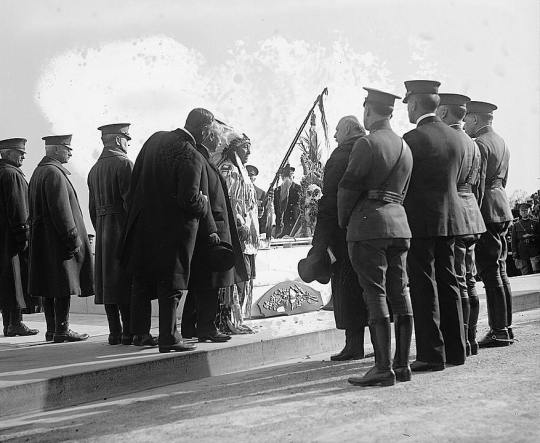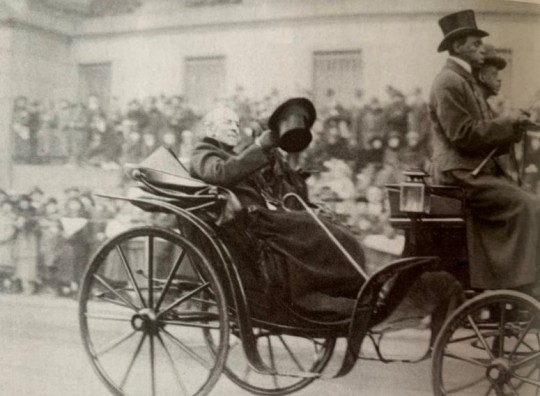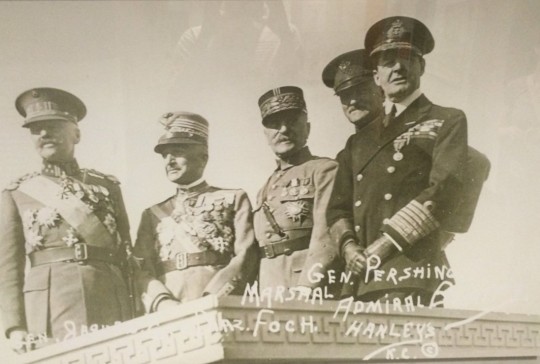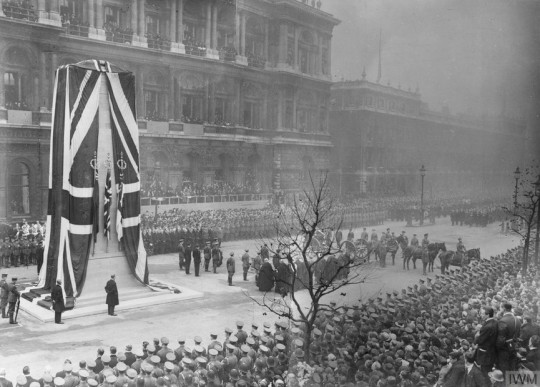#beatty

Chief Plenty Coups of the Crow Nation, pictured at the burial of the Unknown Soldier. The sarcophagus familiar to modern visitors was not completed until 1931.
November 11 1921, Arlington–On Armistice Day 1920, the United Kingdom and France had both buried unknown soldiers in places of honor–the former in Westminster Abbey, the latter under the Arc de Triomphe. In 1921, the United States followed suit. An unknown soldier was transported back across the Atlantic from France, where he laid in state in the Capitol rotunda for two days. On Armistice Day, the same day that the peace treaty with Germany would finally enter into effect, the casket was at the front of a procession down Pennsylvania Avenue as far as the White House, followed on foot by President Harding and General Pershing.

Wilson in a carriage at the end of the procession down Pennsylvania Avenue.
At the end of the procession were Woodrow and Edith Wilson in a rented carriage. The New York World wrote that the “pale face of the man who gave his health and strength to uphold the same ideals for which the Unknown Soldier died seemingly unleashed the pent-up emotions of the watchers.” Wilson did not continue on to Arlington, due to a combination of his health concerns preventing him from climbing the stairs at the amphitheater there, and Harding’s desire not to be upstaged by his predecessor.

General Jacques of Belgium, General Diaz of Italy, Marshal Foch of France, General Pershing of the United States, and Admiral Beatty of the United Kingdom, pictures at the dedication of the Liberty Memorial in Kansas City on November 1.
At the service in Arlington, President Harding gave a brief speech. He was followed by General Jacques of Belgium, Admiral Beatty (who presented the Unknown Soldier with the Victoria Cross), Marshal Foch, and General Diaz. The four military men were at the end of a tour of the United States, along with General Pershing, which also included the groundbreaking of the Liberty Memorial (now the National World War I Memorial) in Kansas City on November 1. Also in attendance were a large number of foreign civilian notables, among them Arthur Balfour and French PM Briand, who were in Washington for the start of the Washington Naval Conference on arms limitation the next day.
The burial service ended with a brief statement by Chief Plenty Coups of the Crow Nation, the sounding of “Taps” on a bugle, and a twenty-one gun salute.
Sources include: Patricia O’Toole, The Moralist (includes image credit for the picture of Wilson).

The Cenotaph, pictured between 10:30 and 11AM on November 11, 1920. The casket of the Unknown Warrior, drawn by a gun carriage, is partially obscured behind a tree.
November 11 1920, London–The official Victory Parade, celebrating the Allied victory in the war, was held in July 1919. It featured a cenotaph–an empty tomb–commemorating all the soldiers of the British Empire who had fallen overseas, their bodies buried there. The 1919 cenotaph was a temporary construction, but it was so popular (over a million people visiting the structure in the week after the parade) that there were soon calls for a permanent version.
The permanent Cenotaph, built on the same site in Whitehall as the temporary one, was built between May and November 1920, ahead of the unveiling on the second anniversary of the Armistice. As part of the ceremony, it was also decided to exhume an unidentified British soldier from France and bury him as the Unknown Warrior in Westminster Abbey (not in the Cenotaph itself, which was intentionally empty).
At 11 AM, exactly two years after the Armistice went into effect, King George V pulled a lever, revealing the Cenotaph from under the two large Union flags that had covered it. The crowd stood in silence for two minutes, the “Last Post” was sounded on bugle, and the King laid a wreath before the unveiled cenotaph before the procession continued to Westminster Abbey. There, the pallbearers, which included Marshals Haig and French and Admiral Beatty, bore the casket inside, where it was interred after a brief and solemn ceremony.
Until closed at midnight, crowds filed by both the Cenotaph and the tomb in Westminster Abbey. Within a week, well over a million had paid their respects, and the Cenotaph was partially buried in a pile of wreaths and flowers over ten feet high.
Wild Dog v1
When I first reviewed this mini-series about 8 months ago, I brushed it off as nothing more than a Marvel Comics’ Punisher rip-off that was riding the coat tails of the Friday the 13th franchise in an effort to appeal to the adolescent market. The truth is, I didn’t really put in the time and effort to thoroughly research this work - and I apologize for that.
As explained by editor Mike Gold, the whole concept behind Wild Dog originated from the fact that all of the big cities in the DC Universe (i.e. Gotham City, Metropolis, Coast City, Opal City, etc) had multiple superheroes protecting them, but who was watching out for the smaller towns in America’s Heartland? Wild Dog was devised to be DC’s answer to that - he was a ‘regular joe’ who used the weapons/tools at his disposal to take down any threats within the Quad City area. Basically, a 'hero’ for small town America. Coincidentally, the creators of Wild Dog both lived in Iowa.
Fun fact: Originally Wild Dog was supposed to be named 'Red Dog’ (as per the logo on his jersey/costume), but it was discovered that one of Hasbro’s G.I. Joe characters was using the name already so a quick alteration was made.
The first issue of this mini-series was the first appearance of Wild Dog in the DC universe. How did a completely brand-new character get to headline his own mini-series without ever being introduced to the DC universe beforehand? Well, I’d wager it would have something to do with the creative team behind the character and mini-series: Max Allan Collins (writer) and Terry Beatty(artist).
If the names Max Allan CollinsandTerry Beatty don’t mean anything to you, then you probably aren’t familiar with Ms. Tree.Ms Tree was a detective-fiction comic book created by CollinsandBeatty that debuted in 1981 under the Eclipse Magazine imprint. It ran for 50 issues before being picked up by DC comics in 1989, and developed a loyal readership along the way. Collins, understudy of Mickey Spillane, was no stranger to writing detective and crime fiction - by 1988 he had already written his 19th mystery novel, had a short stint scripting the Dick Tracy newspaper strip and had a hand in re-introducing the post-Crisis Jason Todd back to DC continuity (Batman #408 to #412). Collins’ love of mystery fiction becomes apparent as you read the Wild Dog mini-series and realize that it’s set-up as a four-issue 'whodunnit’ mystery - the secret identity of Wild Dog is hinted at throughout the mini-series with clues for the reader to try to solve. Wild Dog’s secret identity and back-story is finally revealed in the final issue, but only at Collins’ insistence - editor Mike Gold originally wanted to save the big 'reveal’ for the first issue of the second mini-series (or possible ongoing series). I’m not sure why Collins was dismissive of making it a full-time project. It may have had something to do with Beatty stating, on record, that the motivation for the creation of Wild Dog (the character AND the mini-series) was to pay a few bills and keep the Ms Tree publication afloat. As previously mentioned, while critically acclaimed, Ms Tree was self-published by CollinsandBeatty and was not a very financially profitable venture.
WhileWild Dog may have embodied a lot of trending late 80s comic book elements (ex: excessive violence, a gun-toting anti-hero who doesn’t take prisoners), Collins states that Wild Dog was derived from classic crime-fiction pulp heroes (ex:Zorro, the Green Hornet,the Shadow, etc) but packaged for the GI Joe crowd. As comic books in the late 80s were synonymous with merchandising, Collins has stated that he had started to craft the idea of Wild Dog with the potential of a toy line and Saturday morning cartoon in mind, but his artistic integrity stopped him from 'selling out’ and going down that route.
I remember seeing the ads for this mini-series in several DC titles (as DC was marketing it heavily during 1987) and it really appealed to my 9 year-old self - so much so that about a decade later when I happened upon it for sale at a comic book shop I snatched it up with no delay. I do believe that CollinsandBeatty were trying to create a comic that would appeal to a pre-adolescent audience and they undoubtedly delivered on that goal. You can tell that Collins didn’t take his creation too seriously - as a character in the first issue sees Wild Dog and openly asks if he’s part of a publicity campaign for a new Friday the 13thmovie.
I was unaware of what happened to this character after this mini-series ended (it kind of ends on a cliffhanger). Had I known that it would run as a 7-page feature in Action Comics Weekly #601 to 641 (1988), I probably would’ve made greater efforts to track those issues down. My 9 year-old self still looks at Wild Dog with glee and secretly longs for his massive collection of GI Joe action figures from yesteryear.
Fun fact:Collins was not a fan of characters talking during fight scenes. He cited this as being an annoying comic book cliche and went to great efforts to omit it from his scripts (much to the dismay of DC editors).
Post link

